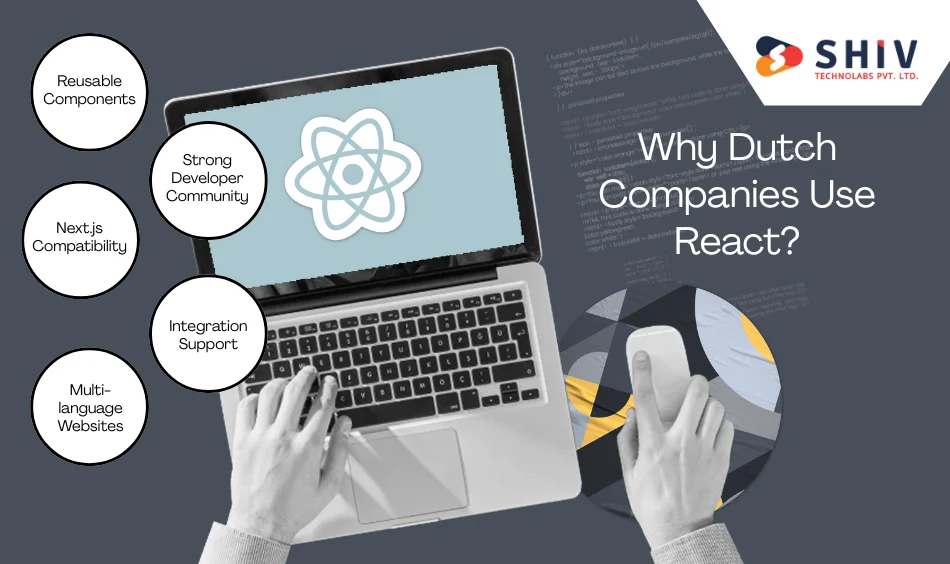Table of Contents
The Netherlands has quietly become one of Europe’s most active tech hubs — especially for front-end innovation. From large eCommerce brands to fast-growing SaaS startups, Dutch companies are betting on React and Next.js to power their digital platforms.
These frameworks help teams build fast, scalable, and multilingual websites that match Dutch standards for accessibility and performance. Whether it’s online retail, banking, or logistics, React has become a common choice across industries.
In this article, we’ll highlight 12 verified Dutch websites built with React and Next.js, explain how we confirmed the tech stacks, and discuss why React continues to dominate over Vue in the Netherlands.
By the end, you’ll understand which Dutch websites use React, why Next.js is so popular, and how React helps local brands stay ahead in digital experiences.
Why React Has Become the Standard in the Netherlands?

In the Netherlands, React is more than just a framework; it’s the default choice for many front-end teams. Companies prefer it for its flexibility, strong developer community, and long-term reliability.
React and Next.js fit the Dutch digital environment well because they make websites faster and easier to manage. From bol.com to Coolblue, many Dutch brands run React-based architectures to support thousands of daily users.
Here’s why React has taken the lead:
- Reusable components save time across projects.
- Performance-first design helps meet Dutch accessibility and Core Web Vitals standards.
- Next.js support makes multilingual websites (Dutch and English) easier to handle.
- An active job market keeps talent easy to find and projects easier to maintain.
- Integration-ready structure works well with tools like Adyen, Mollie, and iDEAL.
For Dutch businesses that handle large product catalogs or online payments, React provides speed, structure, and long-term stability — all essential for eCommerce success.
Verified Dutch Websites Built with React and Next.js
Below is a verified list of Dutch websites that publicly mention React or Next.js in their official documentation, careers pages, or engineering blogs.
Each brand represents how React has shaped real-world digital products in the Netherlands.
| Website | Headquarters | Framework | Proof Source |
|---|---|---|---|
| Coolblue.nl | Rotterdam | React + Next.js | Front-end roles and React Amsterdam talks confirm React use. |
| bol.com | Utrecht | React | The careers page lists React for web development roles. |
| Wehkamp.nl | Zwolle | React | Tech blog details front-end stack based on React. |
| AlbertHeijn.nl | Zaandam | React + Next.js | Hiring pages under Ahold Delhaize mention React/Next.js usage. |
| NS.nl (Nederlandse Spoorwegen) | Utrecht | React | Careers section highlights React for front-end teams. |
| ANWB.nl | The Hague | React | Job listings require React and TypeScript experience. |
| Rabobank.nl | Utrecht | React + Next.js | Developer vacancies confirm React and Next.js stack. |
| Adyen.com | Amsterdam | Preact + React | Tech documentation and careers pages cite Preact/React. |
| Mollie.com | Amsterdam | React + React Native | Engineering blog confirms React-based UI framework. |
| Easy-LMS.com | Delft | React | SaaS product built using React for learning dashboards. |
| Hiltermannlease.nl | Haarlem | React + Next.js | Developer roles mention React, Next.js, and Tailwind. |
| Booking.com | Amsterdam | React | Internships and engineering roles include React in core skills. |
# Quick Insights
- These websites cover a variety of industries — eCommerce, fintech, travel, SaaS, and logistics.
- Each one uses React or Next.js for its public site, not just for internal dashboards.
- The presence of React roles in job listings across these companies shows long-term adoption, not short-term testing.
Together, they represent the growing trend of React adoption in the Netherlands, where developers and agencies use the same stack across retail, finance, and tech startups.
How Did We Select and Verify These Websites?
Before listing the Dutch websites using React and Next.js, we followed a strict process to make sure every example is authentic. The goal was to only include companies where React usage is publicly confirmed through official sources — not guesses or assumptions.
Here’s how we verified each entry:
- Official Careers Pages: We checked if the company lists React or Next.js in front-end job descriptions.
- Engineering Blogs: We reviewed articles and conference talks shared by their developers.
- Company Tech Stack Pages: We included brands that openly publish their technology stack online.
- Cross-checking with Trusted Sources: We compared findings across LinkedIn, GitHub, and event listings like React Amsterdam.
We only added a brand to this list if at least one of these proofs existed. If React was mentioned only for mobile (React Native) or internal tools, we did not include it.
Each example below is verified as either fully built on React or using React/Next.js for a major part of their public-facing web platform.
Why Dutch Companies Use React?

Dutch companies rely on React because it helps them build fast, reliable, and scalable websites without adding complexity. Whether it’s a retail platform with thousands of products or a banking dashboard with secure transactions, React gives teams full control over the user experience.
Here are the main reasons React is so widely adopted in the Netherlands:
- Reusable Components: Developers can create once and reuse across different web modules, saving time.
- Strong Developer Community: The Netherlands hosts active events like React Amsterdam, making it easy to share knowledge.
- Next.js Compatibility: Businesses gain the SEO benefits and faster load times of server-side rendering.
- Integration Support: React works well with Dutch payment systems like iDEAL, Adyen, and Mollie.
- Multi-language Websites: Handling both Dutch and English versions is simple with React’s routing flexibility.
React also fits well with accessibility standards such as WCAG 2.2, which public organizations in the Netherlands must follow. This combination of flexibility, performance, and compliance makes React a long-term choice for Dutch digital teams.
React vs Vue for Dutch Websites
Both React and Vue are popular for building modern front-end experiences, but Dutch companies clearly favor React.
Most large-scale websites and enterprise teams in the Netherlands choose React for its maturity, broader talent pool, and integration options.
Here’s a simple comparison that reflects how React native development service providers view these two frameworks:
| Feature | ReactJS | Vue.js |
|---|---|---|
| Learning curve | Moderate — good balance for teams | Easier for beginners |
| Community in the Netherlands | Very active (React Amsterdam, React Summit) | Smaller but growing |
| Enterprise adoption | Used by top Dutch brands like Coolblue and bol.com | Mostly in small projects |
| SEO capabilities | Strong with Next.js | Good with Nuxt, but less used locally |
| Job demand | High — React developers are in constant demand | Moderate |
| Integration ecosystem | Works with most APIs and CMS tools | More limited for enterprise use |
React’s strong presence in the Netherlands is not just about popularity.
It’s backed by proven scalability, continuous updates from Meta, and the widespread use of Next.js for production-ready applications.
Vue, while lightweight and developer-friendly, remains a secondary choice among Dutch companies that prioritize performance and long-term maintenance.
Are Most Dutch eCommerce Sites Using React?
Yes — most major Dutch eCommerce websites are powered by React or Next.js.
Retailers, fashion brands, and electronics stores use it to deliver fast product listings, dynamic filters, and friction-free checkout flows that work smoothly on both desktop and mobile.
Here’s why React has become the go-to framework for Dutch online stores:
- Fast Product Rendering: React’s virtual DOM allows quick catalog updates and smooth scrolling.
- Dynamic Cart and Checkout: React handles real-time interactions without page reloads.
- Easy Integration with Payment Systems: Works perfectly with iDEAL, Adyen, and Mollie — the most trusted Dutch payment gateways.
- Strong SEO Performance: With Next.js, pages load faster and rank higher on Google.
- Reusable Storefront Components: Developers can maintain brand consistency across multiple product pages.
Examples like Coolblue, bol.com, and Wehkamp show how React supports complex user flows such as personalized recommendations, wishlists, and live cart updates.
As Dutch consumers expect faster and smarter online experiences, React continues to dominate the eCommerce development space in the Netherlands.
Key Takeaways
- React and Next.js have become the top choice for front-end development across Dutch industries.
- 12 verified Dutch websites — including Coolblue, bol.com, Wehkamp, and Rabobank — are officially confirmed to use React or Next.js.
- Dutch developers prefer Next.js for faster performance, better SEO, and multilingual website support.
- React dominates eCommerce in the Netherlands, powering platforms that rely on iDEAL, Adyen, and Mollie payments.
- The Netherlands hosts strong React communities and events such as React Amsterdam and React Summit Europe.
- With React 19 and Next.js 15 on the rise, the Dutch tech scene is preparing for even smarter and more efficient digital experiences.
These trends show that React isn’t just popular — it’s the backbone of how modern Dutch websites are built and maintained.
Work with a React.js Development Company Trusted by Dutch Brands
Looking to build a high-performance web application with React or Next.js?
Partner with Shiv Technolabs — a React.js Development Company in Netherlands that helps startups, retailers, and enterprises create fast, user-friendly digital experiences.
Our team builds React-based solutions tailored for Dutch businesses that value performance and reliability. We design systems that are easy to scale, manage, and localize for both Dutch and English audiences.
Here’s what we can help you with:
- Custom React.js web apps, dashboards, and portals.
- Next.js development for SEO-friendly and multilingual websites.
- Integration with Dutch tools like iDEAL, Adyen, and Mollie.
- Long-term maintenance and version upgrades for existing React projects.
If your business needs a front-end partner who understands both technology and local market demands, Shiv Technolabs is ready to help you build it right.
Conclusion
React and Next.js continue to define how Dutch businesses build and scale their digital platforms. From eCommerce leaders like Coolblue and bol.com to fintech innovators such as Rabobank and Mollie, these frameworks have become the trusted base for speed, scalability, and multilingual support.
Dutch developers and agencies appreciate React for its simplicity and strong community — and the momentum isn’t slowing down anytime soon. As new versions like React 19 and Next.js 15 emerge, Dutch brands will keep finding new ways to deliver faster, more connected user experiences.
If you’re ready to start your React journey, connect with Shiv Technolabs — your development partner in the Netherlands for everything React and Next.js.























